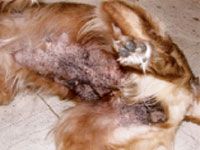Coping with an allergic dog
After years of giving advice all day long to pet owners with allergic dogs, I now have a fresh perspective on the subject-that is after adopting Cindy, an allergic 11-year-old Golden Retriever, a few years ago.
After years of giving advice all day long to pet owners with allergic dogs, I now have a fresh perspective on the subject—that is after adopting Cindy, an allergic 11-year-old Golden Retriever, a few years ago. Surprisingly, I took on the challenge of owning an atopic dog with confidence, believing that now I could finally practice what I preached. The real question was, could I?

A taste of my own medicine: Adopting Cindy, a dog with atopic dermatitis, has been a great learning experience for me as a dermatologist.(PHOTOS: COURTESY OF DR. ALICE JEROMIN)
When I first saw Cindy, I didn't have much to go on, as her history was requested but denied to me from her veterinarian. From the look of her skin, however, she had probably been pruritic for 10 of her 11 years. On a scale of 1 to 10, Cindy is still at times about an 8 in terms of itch factor, but she's happy, playful and a delight to us. Most of all, she is enjoying her life, despite her condition. Do I frequently tell her to stop scratching? Absolutely! Does that bother her? Not in the least.

I wrote this article l½ years ago, after a few months of owning Cindy. I've added a recent status update that includes the highs and lows of the last two years of owning Cindy (who is now 13 years old), what I've done to help her, and an overview of her progress so far.
Cindy's story
When I adopted Cindy, she had ventral abdominal, periocular, perineal and dorsal lumbar alopecia; erythema; lichenification; hyperpigmentation; a "rat tail"; an odor; and otitis. Blood work and urinalysis showed a normocytic/normochromic anemia, but all other results were normal. An ELISA test for inhalant allergy was negative. (I tested her skin later). I immediately started feeding her Iams Veterinary Formulas Skin and Coat Response FP and within two months the anemia resolved. She began to grow hair on the dorsal lumbar area and tail.
Despite this progress, Cindy still had a significant amount of pruritus and seborrhea oleosa. At this point, I was bathing her every other day. After using several different shampoos, I kept coming back to DVM Tearless. Hesitant to be too aggressive with meds and considering her advanced age, I tried to rely on topical treatments and diet. However, after eight to 10 weeks of this approach, it was evident I needed to add something else for the pruritus.
Antibiotics and ketoconazole for the secondary yeast and bacterial pyoderma did not help, so I decided to perform intradermal allergy testing. After Cindy tested positive to some grasses and weeds, I began treating her with a low dose of cyclosporine (25 mg daily) to prevent gastrointestinal upset. Again, not knowing Cindy's history—and whether she was sensitive to medications or had a past history of malignancy—was important in my treatment plan. Although the low amount of cyclosporine was helpful, I had to increase the dose to 50 mg/day, which caused a foul mouth odor after two dosages. Thinking back, I remembered having clients complain of the same signs in their dogs receiving cyclosporine, which was usually followed by gum erythema and eventually gingival hyperplasia. Therefore, I discontinued the cyclosporine with plans of starting allergen-specific immunotherapy in the fall, after our Ohio grass and weed season had passed.
In addition, the entire time she also had a waxy yeast otitis that changed into a yeast/rod bacterial otitis accompanied by a foul odor. I cultured and began treatment with Cerulytic (Virbac) as a wax dissolver, oral Baytril (Bayer) and Baytril Otic (Bayer). The ear pruritus refused to subside no matter which topicals I chose (some with steroids and some without). Toward the end of the summer, the ear problem lessened. Although she still had otitis, the odor and ear rubbing greatly decreased. I did not opt for systemic steroids because she had some urinary leakage and a mild urinary tract infection when I adopted her. My goal was to try and keep her comfortable without them.
Lessons learned
I think we, as veterinarians, have a lot to learn about inhalant allergies in dogs—I know I do. You can read the theoretical stuff all you want, but when you have an itchy dog at 3 a.m., you definitely want to reach for those steroids. Also, shampoos are individual, so treat them as such. For example, when Cindy had a secondary yeast component, the anti-yeast shampoos seemed to make her worse. I have also had several Golden Retrievers in my practice that react adversely to oatmeal-based products. Topicals can be trial and error, so start with the most innocuous products and work your way up from there. Samples are great when available.
Another important lesson: Allergies last a lifetime—I don't think we convey that message nearly enough. Owners need to know there is no quick fix and that these pets are going to require a lot of maintenance and medications over the course of their lifetime. Because we may never be able to give them an itch-free dog, owners who can't accept a little itching should probably not own an atopic dog.
Finally, and most important, even though there is some pruritus (and it's all relative), these dogs can still live a happy life. We just need to find the balance between keeping them comfortable and doing no harm.
Status update
Cindy, now 13 years old, continues to receive the same diet but without meds. Most of her clinical signs have been eliminated with this fish-based diet. She has a fabulous coat, no odor, and, in the middle of an Ohio summer, only a mild left ear yeast otitis. As long as I stay on top of monitoring her ears, they are controlled as well. At the first sign of any ear discharge, I immediately use Cerulytic ear cleaner/wax dissolver with an occasional mixture of Conofite Lotion in Synotic. Throughout the course of this journey, I have learned to never underestimate the power of a good diet with the correct proportion of fatty acids. And despite the fact that Cindy improved greatly in the first two to three months of receiving the diet, it really has taken more than a year to see full improvement.
Applying what I have learned with Cindy to my patients, I always try to convey patience to the owners of atopic dogs. Although topical therapies and diet can be helpful, I advise them not to expect too much too fast. If steroids are brought into the picture — and if they are not strictly regulated — they have the potential to open up a whole new set of problems, such as pyodermas, thin skin and scaling. In some dogs, it doesn't take much to immunosuppress the skin's immunity.
The bottom line is I often feel we use steroids to satisfy human owners rather than to ease dogs' suffering. Many owners are impulsive and want that quick fix. I admit at times I wanted nothing more; however, I'm so glad I waited it out—I truly believe Cindy is healthier for it.
Dr. Jeromin is a pharmacist and veterinary dermatologist in private practice in Cleveland, Ohio. She is a 1989 graduate of The Ohio State University College of Veterinary Medicine and an adjunct professor at Case Western Reserve University's College of Medicine in Cleveland.